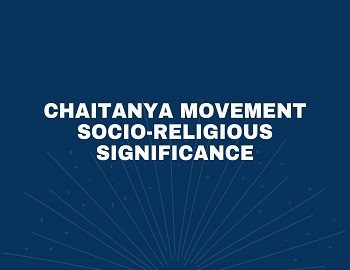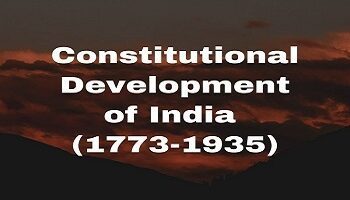Chaitanya Movement: Socio-Religious Significance
The atmosphere of Bengal at the time of the birth of Sri Chaitanya (A.D. 1485) in Nadia was surcharged with worldliness. Very few people followed the path of jnana, and Bhakti cult was at its lowest ebb. In the first twenty-two years of his life, Chaitanya’s reputation as a scholar and a successful teacher had already spread. He was initiated into the Bhakti cult by a Vaishnava saint Ishwar Puri at Gaya, which brought home to his heart the charms of Sri Krishna.
Before embracing asceticism at the age of twenty-four or twenty-five he realized the sweetness of God and the ecstatic joy of communion with God. Immediately after embracing asceticism, Chaitanya introduced the novel way of uttering the names of Hari. He spent the first six years of his life in proselytizing tours through some parts of India; he thus visited Ramesvara, Vrindavana, Kasi, Prayag and Gauda. He converted two great Sankara Vedantines of that time, two influential officials of the court of Hussian Shah, the ruler of Bengal and another Vaisnava saint Krishnadas Kaviraj, the author of ‘Sri Chaitanya Charitmala‘ to his credo.
The secret of Chaitanya’s mission seems to have been that he approached people through their heart by placing before them the beauty, sweetness, love and pleasurable facets of God. He was so popular that some people called him an ‘Avtar of Vishnu‘ himself.
The Bengal Vaisnava movement of which Chaitanya was the mainstay took the detailed idea of Radha Krishna cult. Vrindavan became the great centre of Bengal Vaishnavism in the north and Puri in the South.
The goal of the followers of Chaitanya was to serve Krishna at Vrindavan in collaboration with any one of the four of his associates. In order to concentrate on these ethereal practices, Chaitanya prescribed some external practices and attached great importance to the linking of one’s life around Krishna and his devotees. Humility, tolerance and respectfulness to others were also a necessary embodiment of the movement, coupled with sincerity, simplicity, straightforwardness, contentment and reliance on God.
The Chaitanya school distinguished, according to the degree of predominance, three main aspects of Krishna and three corresponding abodes. At Vrindavan the ‘Madhurya (sweetness) rasa’ (a thing, the taste of which is attended with delicious astonishment due to its sweetness) is overwhelmingly predominant; at Dwarka, different rasas occur in various degrees; and at Vaikuntha, the heavenly abode ‘aisvarya‘ or Godhood predominates. Here Krishna is known as ‘Narayana‘.
Chaitanya wrote no philosophical treatise. But the philosophical views as manifested in the movement is called ‘Achintya Bhedabhedabhav‘.
God according to Chaitanya is Krishna. He is an abode of contrary qualities. Radha is the power of Krishna and there is no difference between them. He is all-pervading, immanent and transcendent. Yet he incarnates in the form of finite mortals and is subject to love. All that is there in the world is a manifestation of some power of God which are Maya, Avidya, Ananda and Sat. The world is real and a manifestation of his power of creativity. Bhakti is the only means of liberation.
The popularity of Vaishnavism in Bengal is entirely due to the effort of Chaitanya whose message of ‘Raga Marga‘ or spontaneous love found an appeal in all the people. It was reachable by all the people.
The Chaitanya Movement believed in the conception of a personal God in the avatars, and in the manifest ‘lilas‘ which is an amplification of the conception of avatars. They emphasized all-embracing love and service of human beings as a method of God-Realization.
The simple and emotional nature of Chaitanya’s teachings made a profound appeal to the oppressed and even brahmins and Muslims were converted. The movement spread rapidly in Bengal, Eastern India and Assam. It grew at the expense of Shaktism and through the conversion of disorganized remnants of Buddhism. Chaitanya disregarded religious token and caste, rites and ceremonies. He exalted the inner graces as honesty, simplicity and sincerity. Members of his sect were not to covet gain, rank or esteem and were to refrain from aggrandisement, self-indulgence and jealousy. Chaitanya favoured marriage, vegetarianism and teetotalism. Chaitanya says, “If a creature adores Krishna and serves his Guru, he is realised from the meshes of illusion and attains to Krishna’s feet.”
The principle sect of Chaitanya under the leadership of gosains remained a highly moral though emotional group. Adoration of the guru singing, repetition of the name of the deity and necklace and rosaries of tulsi beads were prominent in its ritual. Its doctrine was developed by Jivagoswami and Krishnadas Kaviraj in Mathura.
- The Slave Dynasty (1206 – 1290)
- The Khilji Dynasty (1290-1320)
- Tughlaq Dynasty (1320-1414)
- Sayyids & Lodhis
- Disintegration of Delhi Sultanate
- Sufism In India
- Vijayanagar Empire (1336-1649)
- Vijayanagar Empire Cultural Development
- Sher Shah Suri- The Afghan Revival
- The Mughal Empire (1556-1707)
- Cultural Developments in Medieval India– Nios









Comments (No)